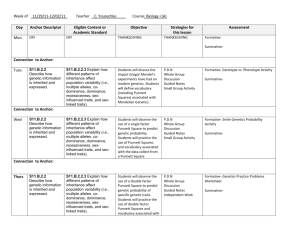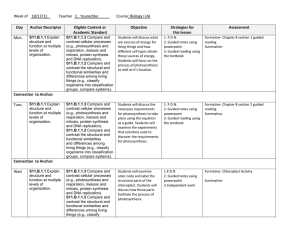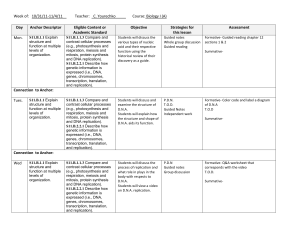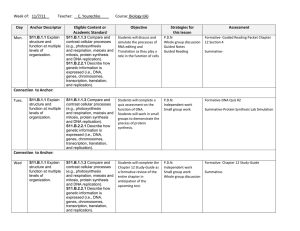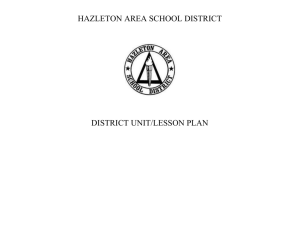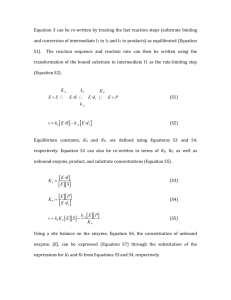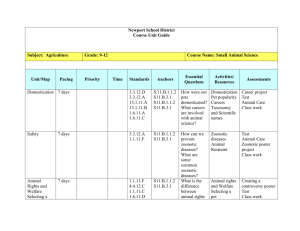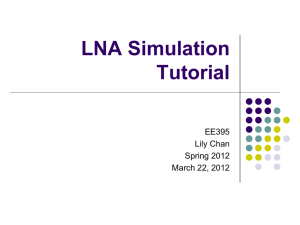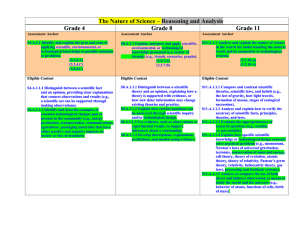Week of 12/19-12/22/11 Teacher C.Yourechko Course: Biology I (A
advertisement
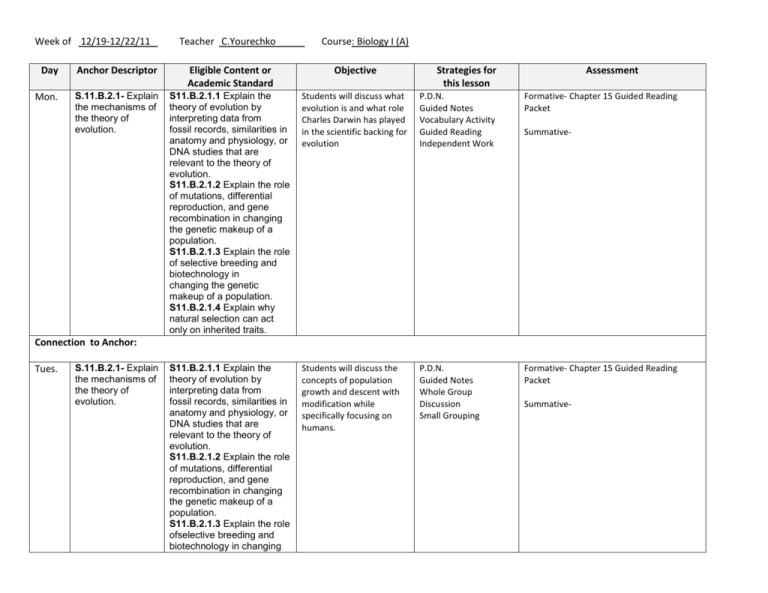
Week of 12/19-12/22/11 Teacher C.Yourechko Course: Biology I (A) Day Anchor Descriptor Eligible Content or Academic Standard Objective Strategies for this lesson Assessment Mon. S.11.B.2.1- Explain the mechanisms of the theory of evolution. S11.B.2.1.1 Explain the theory of evolution by interpreting data from fossil records, similarities in anatomy and physiology, or DNA studies that are relevant to the theory of evolution. S11.B.2.1.2 Explain the role of mutations, differential reproduction, and gene recombination in changing the genetic makeup of a population. S11.B.2.1.3 Explain the role of selective breeding and biotechnology in changing the genetic makeup of a population. S11.B.2.1.4 Explain why natural selection can act only on inherited traits. Students will discuss what evolution is and what role Charles Darwin has played in the scientific backing for evolution P.D.N. Guided Notes Vocabulary Activity Guided Reading Independent Work Formative- Chapter 15 Guided Reading Packet S11.B.2.1.1 Explain the theory of evolution by interpreting data from fossil records, similarities in anatomy and physiology, or DNA studies that are relevant to the theory of evolution. S11.B.2.1.2 Explain the role of mutations, differential reproduction, and gene recombination in changing the genetic makeup of a population. S11.B.2.1.3 Explain the role ofselective breeding and biotechnology in changing Students will discuss the concepts of population growth and descent with modification while specifically focusing on humans. P.D.N. Guided Notes Whole Group Discussion Small Grouping Formative- Chapter 15 Guided Reading Packet Summative- Connection to Anchor: Tues. S.11.B.2.1- Explain the mechanisms of the theory of evolution. Summative- the genetic makeup of a population. S11.B.2.1.4 Explain why natural selection can act only on inherited traits. Connection to Anchor: Wed S.11.B.2.1- Explain the mechanisms of the theory of evolution. S11.B.2.1.1 Explain the theory of evolution by interpreting data from fossil records, similarities in anatomy and physiology, or DNA studies that are relevant to the theory of evolution. S11.B.2.1.2 Explain the role of mutations, differential reproduction, and gene recombination in changing the genetic makeup of a population. S11.B.2.1.3 Explain the role of selective breeding and biotechnology in changing the genetic makeup of a population. S11.B.2.1.4 Explain why natural selection can act only on inherited traits. Students will discuss other scientists theories on evolution and compare them to Darwin’s theory P.D.N. Guided Notes Whole Group Discussion Independent Work Formative- S11.B.2.1.1 Explain the theory of evolution by interpreting data from fossil records, similarities in anatomy and physiology, or DNA studies that are relevant to the theory of evolution. S11.B.2.1.2 Explain the role of mutations, differential reproduction, and gene recombination in changing the genetic makeup of a Students will view the video: Jeff Corwin in the Galapagos Islands and complete a worksheet on the video P.D.N Whole Group Activity Independent Work Formative- Video Worksheet Summative- Evolution Quiz Connection to Anchor: Thurs S.11.B.2.1- Explain the mechanisms of the theory of evolution. Summative- population. S11.B.2.1.3 Explain the role of selective breeding and biotechnology in changing the genetic makeup of a population. S11.B.2.1.4 Explain why natural selection can act only on inherited traits. Connection to Anchor: Fri OFF OFF OFF OFF FormativeSummative- Connection to Anchor: Week of 12/19-12/22/11 Teacher C. Yourechko Course: Biology I (B) Day Anchor Descriptor Eligible Content or Academic Standard Objective Strategies for this lesson Assessment Mon. S.B.1.1- Explain structure and function at multiple levels of organization. S11.B.1.1.2 Compare and contrast the structural and functional similarities and differences among living things (e.g., classify organisms into classification groups, compare systems). Students will discuss the Animal Kingdom and the characteristics of organisms within that kingdom P.D.N. Guided Notes Guided Reading Whole Group Discussion Independent Work Formative- Chapter 26 Guided Reading Packet S11.B.1.1.2 Compare and contrast the structural and functional similarities and differences among living things (e.g., classify organisms into classification groups, compare systems). Students will discuss two (Sponges & Cnidarians) of the invertebrate groups of the Animal Kingdom P.D.N. Guided Notes Whole Group Discussion Guided Reading Packet Formative- Chapter 26 Guided Reading Packet S11.B.1.1.2 Compare and contrast the structural and functional similarities and differences among living things (e.g., classify organisms into classification groups, compare systems). Students will discuss the invertebrate group Worms and dissect an earthworm P.D.N Guided Notes Small Grouping Formative- Earthworm lab Packet S11.B.1.1.2 Compare and contrast the structural and functional similarities and differences among living things (e.g., classify organisms into classification groups, compare systems). Students will discuss three of the invertebrate groups (Mollusks, Arthropods, Enchinoderms). Students will observe a squid dissection demonstration P.D.N. Guided Notes Whole Group Discussion Independent Work Formative- Squid Lab Packet Summative- Connection to Anchor: Tues. S.B.1.1- Explain structure and function at multiple levels of organization. Summative- Connection to Anchor: Wed S.B.1.1- Explain structure and function at multiple levels of organization. Summative- Connection to Anchor: Thurs S.B.1.1- Explain structure and function at multiple levels of organization. Connection to Anchor: Summative- Fri OFF OFF OFF OFF FormativeSummative- Connection to Anchor: Week of 12/19-12/22/11 Teacher C. Yourechko Course: Physiology Day Anchor Descriptor Eligible Content or Academic Standard Objective Strategies for this lesson Assessment Mon. S11.B.1.1 Explain structure and function at multiple levels of organization. S11.B.1.1.2 Compare and contrast the structural and functional similarities and differences among living things (e.g., classify organisms into classification groups, compare systems). Students in groups will outline the respiratory system using a guided outline P.D.N. Guided Outline Small Grouping Formative- Respiratory System Outline S11.B.1.1.2 Compare and contrast the structural and functional similarities and differences among living things (e.g., classify organisms into classification groups, compare systems). Students will discuss the function and anatomical structures of the respiratory system P.D.N. Guided Notes Whole Group Discussion Formative- Respiratory Diagrams and color coding activity S11.B.1.1.2 Compare and contrast the structural and functional similarities and differences among living things (e.g., classify organisms into classification groups, compare systems). Students will discuss environmental factors as well as diseases that impact the respiratory system. P.D.N Guided Notes Small Grouping Whole Grouping Independent Work Formative- S11.B.1.1.2 Compare and contrast the structural and functional similarities and differences among living things (e.g., classify organisms into classification groups, compare systems). Students will discuss medical testing for the respiratory system using a case study analysis P.D.N Small Grouping Whole Group Discussion Formative- Case Study Analysis Summative- Connection to Anchor: Tues. S11.B.1.1 Explain structure and function at multiple levels of organization. Summative- Connection to Anchor: Wed S11.B.1.1 Explain structure and function at multiple levels of organization. Summative-Respiratory Quiz Connection to Anchor: Thurs S11.B.1.1 Explain structure and function at multiple levels of organization. Connection to Anchor: Summative- Fri OFF OFF OFF OFF FormativeSummative- Connection to Anchor:
